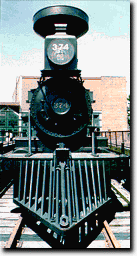
Canadian Pacific Corporate Archives Reference Paper
Locomotive No. 374, A Historical Summary
 While Canadian Pacific began to acquire locomotives from the time of its incorporation in February 1881, the locomotives purchased initially were constructed by, and to the designs of, outside locomotive builders. In July 1883, with the hiring of F.R.F. Brown as the Company's second locomotive Superintendent, the Company embarked upon a program of designing its own locomotives to standard patterns. In the same year, 1883, Canadian Pacific opened its so-called New Shops on Delorimier Avenue in Montreal. The first locomotive outshopped was the first of Brown's standard designs to be built. Class Sa 4-4-0 No. 285 was completed and placed in service in December 1883. While Canadian Pacific began to acquire locomotives from the time of its incorporation in February 1881, the locomotives purchased initially were constructed by, and to the designs of, outside locomotive builders. In July 1883, with the hiring of F.R.F. Brown as the Company's second locomotive Superintendent, the Company embarked upon a program of designing its own locomotives to standard patterns. In the same year, 1883, Canadian Pacific opened its so-called New Shops on Delorimier Avenue in Montreal. The first locomotive outshopped was the first of Brown's standard designs to be built. Class Sa 4-4-0 No. 285 was completed and placed in service in December 1883.
The third of Brown's standard classes was the class Sc passenger locomotive, of 4-4-0 type and having 69-inch driving wheels, A group of eight such locomotives, numbered 371-378, was constructed at Canadian Pacific's New Shops on Delorimier Avenue in Montreal between May and July 1886. Sent to the Pacific Division to operate on the Cascade Section between North Bend and Port Moody, two of them figured in significant historical events: - No. 371, having been placed on the train at North Bend, hauled the first Pacific Express into Port Moody, BC, on 4 Jul 1886. This was the first scheduled train to cross Canada from sea to sea.
- No. 374, also heading the consist from North Bend, hauled the first passenger train to go beyond Port Moody over the 12-mile extension to Vancouver, on 23 May 1887.
While No. 371, still essentially in its original form was scrapped in October 1915, No. 374 had a different fate. In September 1914, it was selected for a complete rebuilding, which gave it an additional thirty-year lease on life. It remained in revenue service until July 1945, when it was retired. It should be added that in its post 1914 form, this unit was an almost completely-new locomotive, built upon the main frame of the original 1886 locomotive. Nonetheless, the link between the 1914 engine and its 1886 ancestor, however tenuous, is regarded by historians as valid.
After its 1945 retirement, the locomotive was donated to the City of Vancouver as a memento of the original No. 374. Prior to delivery to the city, Canadian Pacific gave it a cosmetic treatment at its Angus Shops in Montreal, to make it look "old". The necessity to remove some modern technology to achieve this goal rendered the locomotive permanently inoperative. After delivery to Vancouver, it was placed on a section of track at Kitsilano Beach, where it remained for 38 years until 1983. At this time, funds having been found to effect a further - and badly needed - cosmetic restoration, the locomotive was removed from Kitsilano and placed in a warehouse on Granville Island, Vancouver. There, in 1985, the cosmetic work was carried out by members of the West Coast Railway Association and the Canadian Railroad Historical Association.
When this project was undertaken early in the 1980s, it was the intention to restore the locomotive exactly to its 1886 appearance. However, the 1914 rebuilding prevented this from being done. The new boiler, firebox, smokebox, cylinders, and other major components applied in 1914, were different in size, shape, and design from the originals. As a result, the combined WCRA/CRHA groups decided that the most practical approach would be to restore the 1945 cosmetic appearance, and perhaps improve slightly upon it. Essentially, the major visual differences between the 1945 and 1887 appearances are: - A larger diameter boiler set about eight inches higher than the original.
- The positioning of the steam dome above the third course of the boiler rather than above the firebox.
- The locomotive now has 63-inch driving wheels rather than the original 69-inch ones.
- The piston valves above the cylinders have been cut off and replaced with square hollow metal boxes to represent the original slide or "D" valves.
There has been some suggestion from persons with little knowledge of railway technology that No. 374 should be put in operating condition. It must be appreciated that to do so would mean replacing so much of the present locomotive that it would be simpler merely to construct a full-sized replica. The present locomotive, even in its "mongrel" form, is at least, and for the most part, an example of 1880s technology modernized thirty years later. As such, it has a historical significance to Vancouver.
Omer Lavallee - Corporate Historian and Archivist, Canadian Pacific Limited, Montreal.
Back
|